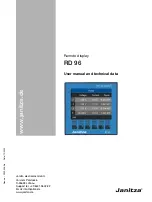
DA-660-8/16-CE User’s Manual
Introduction
y
Web Server (HTTPD)
—Includes ASP, ISAPI Secure Socket Layer support, SSL 2, SSL 3,
Transport Layer Security (TLS/SSL 3.1) public key-based protocols, and Web Administration
ISAPI Extensions.
y
Dial-up Networking
—Consists of a RAS client API and Point to Point Protocol (PPP). RAS
and PPP support Extensible Authentication Protocol (EAP) and RAS scripting.
Obtaining the Firmware Build Version
There are three ways to obtain the firmware version of the DA-660 embedded computer. This
information is particularly important for feature identification.
y
Examine the welcome message after you log on to the computer.
y
Log on to the Web-based management system (described in a later chapter) to view the system
information.
y
Check the firmware version on the LCM display.
Memory and File Systems
The DA-660-8/16-CE file system allows file storage on the system RAM or on the onboard flash
memory. Files can also be stored on external media such as a USB drive or CompactFlash card.
RAM-based Storage
About 20 MB of the 128 MB SDRAM is available for user applications and data. The operating
system and kernel image occupy the rest of the space. The root directory is stored in RAM, along
with subdirectories such as “Windows”, “Temp”, “My Documents”, “Network”, and “Program
Files”. Files can be temporarily stored in these directories, but they will be deleted when the
system is shut down or restarted. Persistent files and programs should be placed in the
“NORFlash” directory.
Onboard Flash Memory Storage
Onboard flash memory storage is provided through the “NORFlash” directory. Anything that is
saved in this directory will be retained when power is disconnected or lost. 15.5 MB of storage is
available.
External Media Storage
When external media is installed, such as a USB drive or CompactFlash card, it will be found as an
additional directory. For data that is intended to be shared with a PC, the external media should be
formatted using the PC’s FAT file system.
Caution When Storing Data
It is recommend that the onboard NOR flash be used for storing programs only. For log data
generated by your programs, use external storage media such as CompactFlash or a Network File
System. CompactFlash is much easier to replace if it is damaged or full.
NOR flash memory has a life cycle of 100,000 write operations at the block (128 KB) level. It
does not support BBM (Bad Block Management). For this reason, a FAT file system would not
know if a flash block has reached the end of its life cycle. The FAT file system would continue to
scan the block again and again, eventually resulting in an unpredictable state.
1-5









































